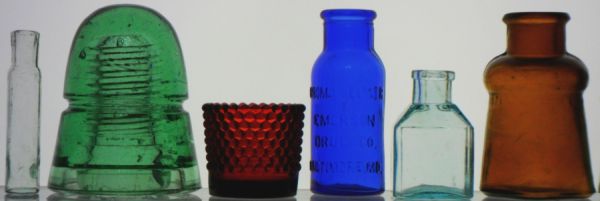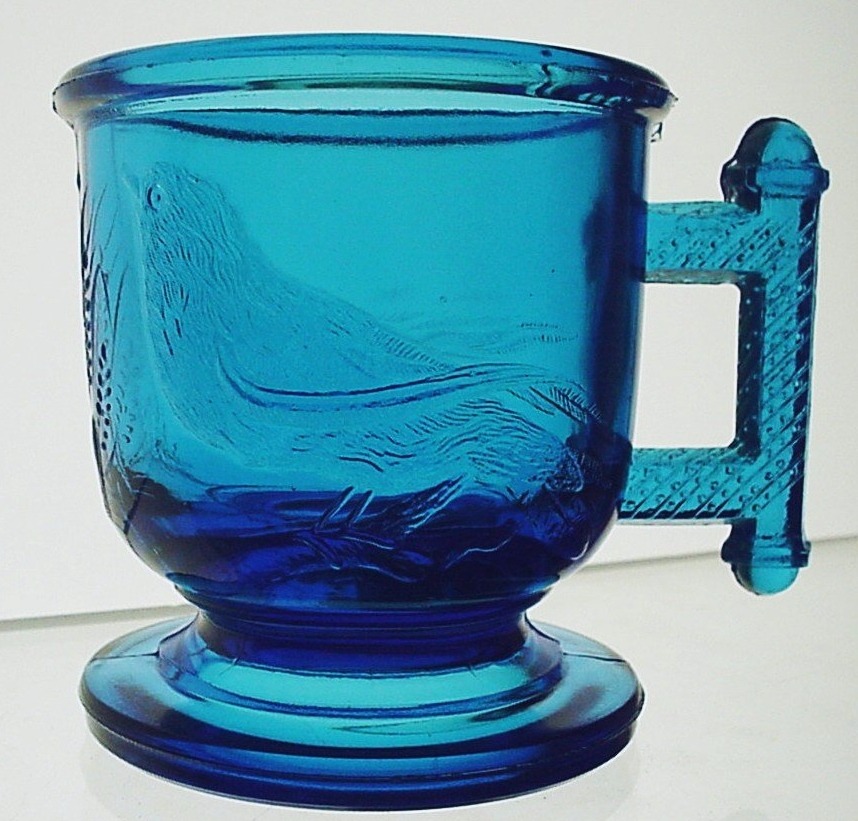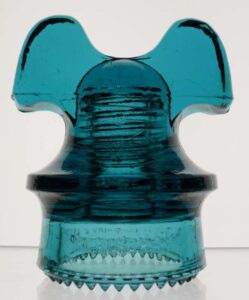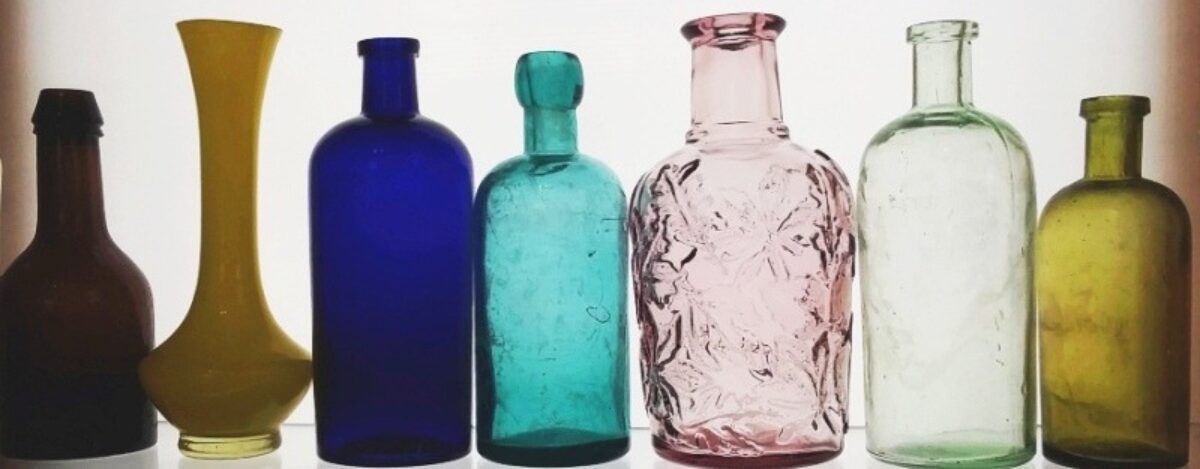GLASS BOTTLE MARKS ~ HOME PAGE
Hi there ~ I’m interested in the general history of the glass manufacturing industry in the United States, especially that of container glass, electrical insulators and tableware (both pressed and blown). Antique bottles, Fruit jars, Glass insulators, EAPG, Depression Glass, Milk Glass, antique children’s mugs, fishing net floats, and other items are some of the forms of glass I enjoy learning more about. My “GLASS BOTTLE MARKS” website attempts to discuss those subjects and more.
A lot of great information about glass is already available on the web, as well as in numerous books and magazines, but I’ve tried to gather some of the very best, basic info together onto this site, in particular concentrating on glass manufacturers’ identification marks found on bottles, fruit jars, insulators and tableware. I’m also in the process of adding various research articles to this site, with histories or summaries on a number of glass companies, and information about different types of collectible glass and glass items.

The glassmaking industry in the United States is a huge field that dates back to the seventeenth century, and covers a vast array of items and applications, including both handmade and machine-made glass.
According to historian Rhea Mansfield Knittle (Early American Glass, 1927), one of the earliest glass manufacturers in the US (not counting the unsuccessful attempts at Jamestown in 1607 and 1621) who may have produced considerable quantities of glassware and actually met with some degree of success, was Johannes Smedes (or Jan Smedes) who operated an establishment – probably making bottles for the most part – sometime in the period of 1654-1664 at New Amsterdam (now New York City).
What is glass?
Although some collectors and researchers might consider this a question with a fairly “obvious” answer, it’s not quite as simple as that. For a brief, basic discussion on glass (especially concerning the most common type of glass used for containers and tableware), check out my webpage here: What is Glass?
Every glass object, even the most lowly, commonplace glass bottle, has a story behind it, although all of the precise details may never be known. Where was it made? What was the name of the company or factory where it was produced? How old is it? Is it handmade? Was it mass-produced by machine methods? What type of glass is it made of? What elements/chemicals were included in the glass formula or “recipe”? Why is it a certain color? If it’s an older, hand-blown bottle, who was the glassblower who fashioned it? Who was the last person who used it and handled it before it came into your possession? Where was the physical location of the sand supply that eventually was turned into the glass piece that you hold in your hand? Is it American-made, or a piece that was produced outside the United States? Are there letters, numbers, emblems or other graphics embossed into the glass itself? Can the factory or company/glassmaker be identified by the markings on it? What do the markings mean?
Some or all of these questions might come to mind to the collector or layman, student, flea market shopper, historian, researcher, archaeologist, or casual hobbyist. And my site attempts to answer, in at least some cases if possible, these questions: Where, approximately when, and by what company was this piece of glass made?
ADVERTISEMENT
Glass making factories in earlier days were, for the most part, rather unpleasant places … the general inside environment could be, and often was, brutal. It was extremely hot (especially in the warmer months), noisy, dirty, and dangerous for a number of reasons. Injuries, especially burns and cuts, were commonplace. Fire was always a potential occurrence, and many early factories were destroyed by fire, sometimes leading to the complete closing down of a plant and/or failure of a company.
Antique and vintage glassware of all types and styles that are collected, studied and appreciated today are the tangible artifacts and testaments to the remarkable creativity, sheer hard work, energy, endurance, perseverance, and innovation of those men (and women, as well as many young children in the days before the enactment of child labor laws) who worked in those earlier factories.
Five of the webpages on this site list glass manufacturers’ identification marks (alphabetically listed) seen on container glass (bottles, jars, flasks, jugs, etc.) and on other types of glass including handmade and machine-made tableware and cookware.
A few examples of “glass bottle marks” on utilitarian containers would be “I inside a diamond” , “B in a circle“, “R & CO“, and “N inside a square”.
This link points to “PAGE ONE” of the alphabetical mark listings, with introductory information and explanatory comments:
Glass Manufacturers’ Marks on Bottles and Other Glassware, Page One

On this site are a number of individual web pages with basic information on some of the glass factories that operated in the United States. To read any of the glass company profiles I’ve posted (so far) on the Glass Bottle Marks site, and other articles pertaining to glass, please look along the right-hand sidebar of any page (on a computer screen) or at the bottom of the page (on mobile devices) for the menu of “Glass-Related Articles”, and click on any link in that list. I hope to post more articles and add more information as time and energy permits!
One page in particular within this site is a list of glass factories that manufactured, or are believed to have produced, glass electrical insulators for telegraph, telephone and/or power lines. Although mainly listing U.S. factories, a few Canadian factories are listed also. Click here to go directly to that page: ALPHABETICAL LIST OF GLASS INSULATOR FACTORIES / MANUFACTURERS.
If you have additional information, please contact me (at the email address listed on the Contact Information page on this site) as I’m continually looking for the most accurate data available on these companies. Sources of some of the information is included after each entry if I have it available. I’d appreciate any additions, corrections, or suggestions you may have!
NOTE: Searching for words embedded in the text and COMMENTS sections of each page on this site
Many readers have landed on this site after a keyword search on one of the online search engines such as Google or Bing. The search results page may have included a brief snippet of text from this site. A quick keyword search of the text and especially the COMMENTS section (at the bottom of this and other pages on the site) might be helpful.
On some pages, there are hundreds of comments. (On this Welcome page alone, there are over 700 comments archived here). On a computer screen, press the CTRL key, and (while holding it down) the F key (Find) on your keyboard. Then type in a word or letters you are looking for in the search box. This should scan all the text on this page including the comments – this may help to find a search term you were interested in – a specific glass factory name, business or company name, city or state name, or other words, phrases or initials contained within the text.
If you are using a mobile device, look for the “three stacked dots” or “three horizontal lines” (Menu) along the top or bottom of the screen, tap and look for “FIND IN PAGE” in the dropdown menu. Select that option and a keyboard should appear. Type in the word or phrase to see if it appears within the text or the comments section on that webpage. I hope this helps!
ADVERTISEMENT

Some of the information on glass insulators is from research originally compiled by N. R. Woodward, creator of the “CD” (Consolidated Design) numbering system now used worldwide by collectors for identifying and cataloging insulators. A portion of the info in this site pertaining to insulator manufacturers is drawn from various articles in the classic 2-volume reference book “INSULATORS: A HISTORY AND GUIDE TO NORTH AMERICAN GLASS PINTYPE INSULATORS“ by John & Carol McDougald (published in 1990).
The glass insulator pictured here, a blue aqua or “Hemingray Blue” CD 257 “Mickey Mouse”, is a type made for power lines, made by the Hemingray Glass Company at their factory that operated in Muncie, Indiana.
This site is a “work in progress” started in February of 2004. Originally, the core material was posted as a “sub-page” on the umbrella site Myinsulators.com (hosted by webmaster Bill Meier), but in September of 2012 I moved to my own “Glass Bottle Marks” domain name, and have since expanded this site with additional articles. I would also like to thank the many people around the country (and some from outside the US) with whom I’ve communicated by email, and who, over the years, have sent me photos of glass marks, some of them posted in the alphabetical listings.
I hope this website will be of help in your quest to discover more information concerning the wide world of glass and glass manufacturing. Please be sure to bookmark my site, and return often!
Thank you!
~David
COMPLETE LIST OF ALL ARTICLES ON THIS SITE
SURNAME-ORIENTED ANTIQUE BOTTLE COLLECTING
GLASS MANUFACTURERS MARKS -ALPHABETICAL PAGES – PAGE ONE
ADVERTISEMENT



Hello there. I am older and trying to figure out some of my father’s old glass insulators. One is clear with a fluted bottom. “Made in USA” with looks like “17B” underneath it. “Hemingray -42” and look like “8” with 2 rows of 4 each of dots. Can you help me figure this out please? Thank you!
Hello Janet,
Your Hemingray-42 insulator is classed as a “CD 154” in the system of identification used by insulator collectors. The type was made from 1921 to about 1962. On your insulator, the “17B” is a mold number (Identifying the number of the mold the insulator was formed in at the factory). The “8” plus 8 dots is a date code that stands for 1946, the year the insulator was made. (The “8” actually stands for 1938 which is when the mold was made – but you add one additional year for each raised dot). The small rounded “teeth” on the bottom are called “drip points”. I have a little information on the Hemingray-42 style insulator on my webpage about Hemingray Glass Company. I hope this helps!
David
Hello there, I have a Boyd’s Genuine porcelain lined cap with a number 8 in the center. I’m doing research on it however, I can’t seem to find anything that talks about this specific item. Can you please help me with the issue at hand? Thank you!
Hi Brandy,
Those milk glass liners often bear mold numbers, which is what the “8” is. That number identified the exact mold that was used to form the liner at the factory. The glass factory would have had a number of identical molds, each numbered (for instance – perhaps 1 through 30 or higher), so if any problems came up with the finished product the defective mold could be quickly identified. The numbers have no other significance and can’t be used to date a piece, although sometimes larger, cruder-looking numbers may indicate older liners. If you haven’t seen my webpage here, I tried to gather what little information I could onto one page about those discs. Here it is: Boyd’s Genuine Porcelain Lined Cap
Unfortunately I can’t identify the maker of your liner or the exact age.
Thanks for your comment and I hope this helps a little!
~David
Hello, I am having a hard time finding precise information on this piece of glass I found on the beach in South Texas yesterday. Any information would be appreciated. Thanks. It is dark green and says BBCo on a raised surface. Like a badge almost.
Hello Ben,
[Readers, Ben contacted me by email and sent me photos of his beach glass find, so I wanted to share my answer so it’s archived on the site]. You have found a “seal” from the shoulder of an antique wine bottle. Doing a web search, I found only one example online of a bottle bearing an identical seal on the shoulder. It is one of the “RICKETTS type” black glass bottles. Most of those bottles were marked on the base with “H. RICKETTS & CO” or some similar variation.
The “B B Co” is part of what is called a “SEAL” which was a small glob of molten glass affixed to the side of wine bottles and then “stamped” with a specialized tool which makes it look almost like a coin, disc or large button. Sometimes the seals get detached from bottles when the bottles are broken, and they end up in “beach glass” or are occasionally found in old trash dumps or old privies.
The so-called “Seal bottles” are a type of bottle in demand by antique bottle collectors. There were many, many different personalized seals placed on bottles, usually affixed to the shoulder area, and for various reasons. The heyday of seal wine bottles was from the 1650s to the 1880s, although many more recent bottles have a similar-looking “seal” placed on the side. Many of the seal bottles were made in England as well as several countries in Europe including Germany, France, Spain and the Netherlands. Some were also made in the United States but most of those date after around 1820.
The name or initials in the seal would usually stand for a wine merchant, tavern owner, club or group, or a patron for whom the bottle was blown. In some cases, it identified a bottle in the private collection of a wealthy wine connoisseur. (The seal type bottles were slowly being phased out by the 1860s-1880s, although some more recent bottles may bear some type of seal, such as the common Paul Jones, Louisville, KY whiskey bottles of the 1890s-1910s).
I think some very exclusive, limited edition wines, bottled for a wealthy wine collector, might still have special seals put on them even today, but I haven’t researched that so I’m not sure. Other modern bottles, such as Makers Mark whiskey, bear “imitation” shoulder seals that are not applied, but formed as part of the bottle mold.
MOST of the Ricketts bottles were “generic” ale, beer, spirits and wine bottles on which a seal was never added. I do not know what the “B.B. Co” in this seal represents, but more than likely it is the initials for the name of a wine and spirits merchant in Great Britain. The Ricketts bottles were made over a very long period of time, from 1821 to around 1853. Most were made in Great Britain. Some of a similar style were believed to have been made here in the US also. Most were made in dark olive green or dark olive amber glass, often called “Black Glass”, as the bottles look nearly black in reflected light. (There is also a chance that that particular seal was stamped on other bottles available in that area and time period, not just on Ricketts bottles).
Here is a PDF file, an article written by bottle researcher and archeologist Bill Lockhart and others. It does get “into the weeds” but it makes some interesting reading if you some free time!
Ricketts Firms – Sha.org
I cannot date your find precisely, but I think it most likely dates from sometime in the 1820s or 1830s, possibly 1840s? I found only ONE example on the web of a Ricketts bottle with a similar “B.B.Co.” seal on it. It is a past ebay listing, indexed into the Worthpoint site database. Unfortunately, there is only one photo shown and it is not especially sharp and clear. But it will give you a good idea of what this bottle looks like. The seller writes “1830s” and that is their guess, but that would likely be in the ballpark.
https://www.worthpoint.com/worthopedia/ricketts-co-glass-works-beaded-seal-414177508
Also, just as a side note, there are a number of unrelated bottles that bear “B.B.CO.” on the base or the front (see my entry for B.B.CO in the alphabetical mark listings here) but they would have no connection with the seal from your bottle.
Thanks and take care,
David
I recently purchased a small uranium glass pitcher and was interested in finding out more about the manufacturing company. The stamping on the bottom is A&J, but I couldn’t find that listed on your site for glass manufacturers.
Hello Nick,
You have found a green Depression-era pitcher made by Hazel Atlas Glass Company for the A & J Manufacturing Company of Binghamton, New York. A&J specialized in manufacturing kitchen-related products such as mixers and egg beaters, and evidently the company had a business arrangement with Hazel Atlas to mark certain accompanying glass products (such as the pitcher that also served as the bottom container for a food mixer) with the “A & J” initials. The pitcher was patented in 1923. A & J was acquired by EKCO, of Chicago, IL, in 1929.
I am not sure if more pitchers were marked with those initials AFTER 1929. From the rather large numbers of those types of pitchers still in existence, I would guess they may have, since the green color was very popular throughout the Depression era and large numbers of those pitchers were made throughout the 1930s. So possibly they continued to use the molds with the A&J initials even for several years after the EKCO takeover.
Here are two articles with more background information:
https://americanhistory.si.edu/collections/nmah_867299
https://www.madeinchicagomuseum.com/single-post/ekco-products-co/
Thanks for the post, and I hope this helps! (Yes, I should add that one to my list of marks, thank you!)
~David
Thanks David for answering my question. And the two article links were very informative, especially the one about the ECKO company. So now the green glass pitcher that sets on the shelf in Alaska will make me think of my home state of New York, where the A&J company existed.
You’re welcome, and thank you Nick for the post!!
~David
Is there a way I can send you 2 pictures of a bottle and the makers mark that I found today?
Hi Amy,
Please check the “Contact Information” page. If you are viewing on a computer, see the list of article titles on the right hand side of the page (any page) and the contact info webpage is listed near the bottom of the list. On a smartphone, look for the “MENU” button and then click “List of all articles on the Glass Bottle Marks website” and scroll to the contact information webpage. Thank you for your post!
David
A small clear bottle about three inches high, with a lipped top for a stopper, has C B & S on the base. It was found in 1990 at Northampton, England, as part of an archaeological excavation. Does anyone know the company name?